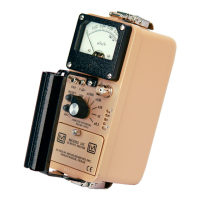Model 14C Survey Meter
Ludlum Measurements, Inc. Page 3 July 2022
CONNECTING A DETECTOR TO THE INSTRUMENT
Caution!
The detector operating voltage (HV) is supplied to the detector via the detector input
connector. A mild electric shock may occur if you make contact with the center pin of the
input connector. Switch the Model 14C range selector switch to the OFF position before
connecting or disconnecting the cable or detector.
Connect one end of a detector cable to the detector by firmly pushing the
connectors together while twisting clockwise a fourth of a turn. Repeat the process
in the same manner with the other end of the cable and the instrument.
BATTERY TEST
The batteries should be checked each time the instrument is turned on. Move the range switch to
the ×1000 position and press the BAT button. Ensure that the meter needle deflects to the battery
check portion on the meter scale. If the meter does not respond, check to see if the batteries have
been correctly installed. Replace the batteries if necessary.
INSTRUMENT TEST
After checking the batteries, turn the instrument range switch to the ×1000 position. Place the AUD
ON-OFF switch in the ON position. Expose the internal detector to a check source. The instrument
speaker should emit ˝clicks˝ relative to the rate of counts detected. The AUD ON/OFF switch will
silence the audible clicks if in the OFF position. It is recommended that the AUD ON/OFF switch be
kept in the OFF position when not needed in order to preserve battery life.
Check the meter reset function by depressing the RES pushbutton switch and ensuring the meter
needle drops to ˝0˝.
Once this procedure has been completed, the instrument is ready for use.
READING THE METER-FACE DIAL
Reading the meter face is very important for consistent measurements. There are, in general, three
types of meter faces: 1) count rate (typically cpm [counts per minute]); 2) exposure rate (typically
mR/hr); and 3) “combo” (typically cpm and mR/hr). The following examples are intended to help
the user interpret the correct reading.
The normal procedure is to turn the range selector switch to the highest range, and if no readings
are seen on the meter, turn the selector switch down to the lower scales until a reading is seen. The
ranges on the instrument selector switch are multipliers for the meter reading. A typical single scale
(one arc) meter face with a cpm (counts per minute) dial is shown below.

